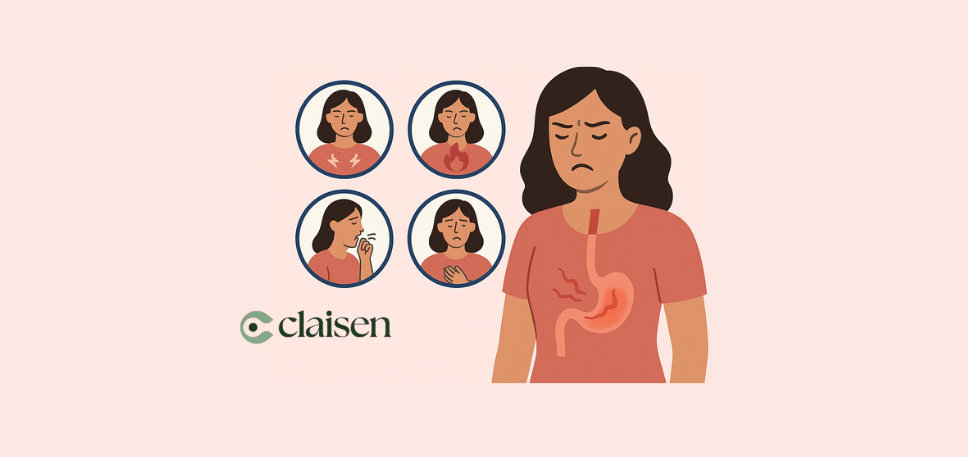
GERD Symptoms in Women: Why They Differ and How to Treat
|
|
Time to read 4 min
|
|
Time to read 4 min
Gastroesophageal reflux disease (GERD) affects millions worldwide, yet women often experience unique symptoms and triggers.
Understanding why GERD symptoms in women differ from men can guide more personalized treatment plans and lifestyle adjustments.
This guide covers the root causes, common female-specific symptoms, and targeted lifestyle and dietary modifications for women to help them in their GERD journey.
Already tired of scrolling through blogs and wondering what might work for you?
Don't worry, Claisen got you covered!
Estrogen and progesterone levels fluctuate throughout the menstrual cycle, pregnancy, and menopause.
Progesterone relaxes the valve that prevents acid from reaching the esophagus, increasing acid reflux risk.
During pregnancy, elevated progesterone and pressure from the growing uterus increase GERD symptoms.
Women have a smaller stomach volume and higher body fat percentage, which can increase intra-abdominal pressure.
Differences in gastric emptying and motility: Food and acid stay in the stomach longer, so acid may linger in the esophagus.
Let Claisen take the guesswork out of your routine with personalized solutions designed to target your problem at its root, so you can feel better, faster.
Spend three minutes per day massaging reflex points on your feet linked to the stomach and esophagus.
This gentle stimulation can encourage better digestive flow and reduce tension
Struggling with Constipation, Heartburn or Bloating? Checkout our other blogs too!
Chia Seeds: Soak 1 teaspoon of chia seeds in half cup of water for 10 minutes and drink before eating. The gel of chia seeds coats the esophagus, reducing direct acid contact.
Psyllium Husk: Mix 1 tablespoon of psyllium husk with water, wait two minutes, then gulp it down 15 minutes before eating. The soluble fiber creates a protective gel layer in your stomach.
Alkaline Salad Dressing: Whisk together 2 tablespoons olive oil, half a lemon juice, and 1 teaspoon baking soda, then drizzle over your salad. This help reduce reflux episodes after meals.
Women in specific life stages face unique GERD challenges:
# During Pregnancy:
Avoid lying flat and use pillows for support.
Consume small, frequent snacks and avoid trigger foods.
Speak with an obstetrician about safe antacids or H2 blockers.
# During Menopause:
Contact a healthcare provider if you experience:
Difficulty swallowing or food getting stuck in the throat
Vomiting, weight loss, or bleeding in vomit/stool
Severe chest pain with no relief from antacids
Symptoms that interfere with daily life or sleep quality
Including gentle exercise, weight lifting in your routine can help strengthen your core and help with GERD symptoms.
Always consult your healthcare provider before starting new supplements or routines.
Skip the guesswork with people who claim they have a "solution". Get a personalized relief plan that stops the cause of your GERD symptoms.
Claisen is a 100% online platform designed to provide personalized relief for bloating, gas, and heartburn: perfect for expecting moms looking for safe and effective options.
With Claisen, you can skip the guesswork and get instant relief.
Yes. Women often report more non-acid symptoms like nausea, bloating, and chest discomfort, while men tend to experience classic heartburn more frequently.
Yes. Menopause, menstrual cycles, and hormonal therapies can influence and increase reflux episodes.
Smaller meals, upright posture after eating, avoiding trigger foods (spicy, acidic, fatty), and stress management can significantly reduce symptoms
Yes, Hormonal shifts relax the lower esophageal sphincter, and the growing uterus increases pressure on the stomach, both contributing to reflux.


